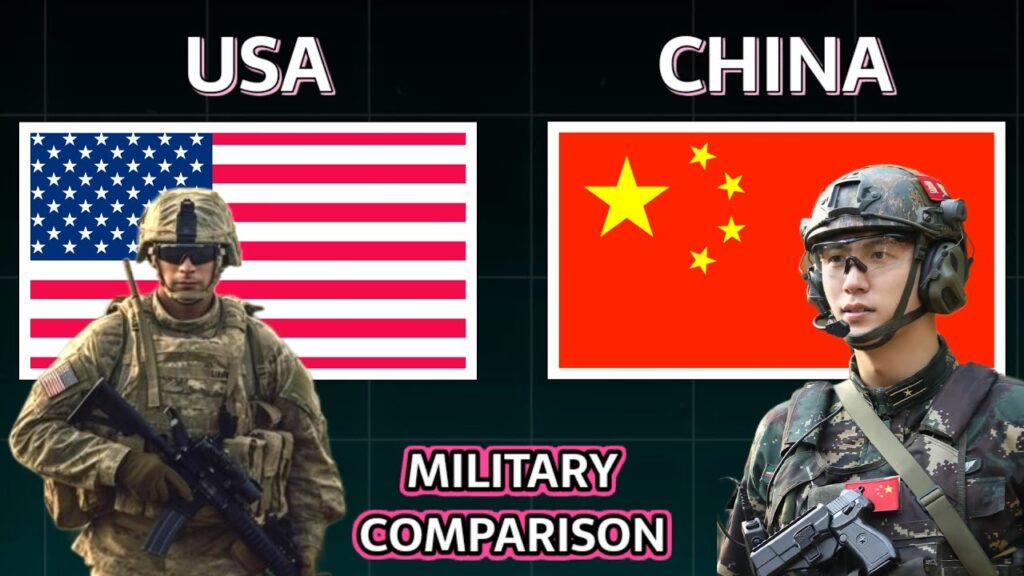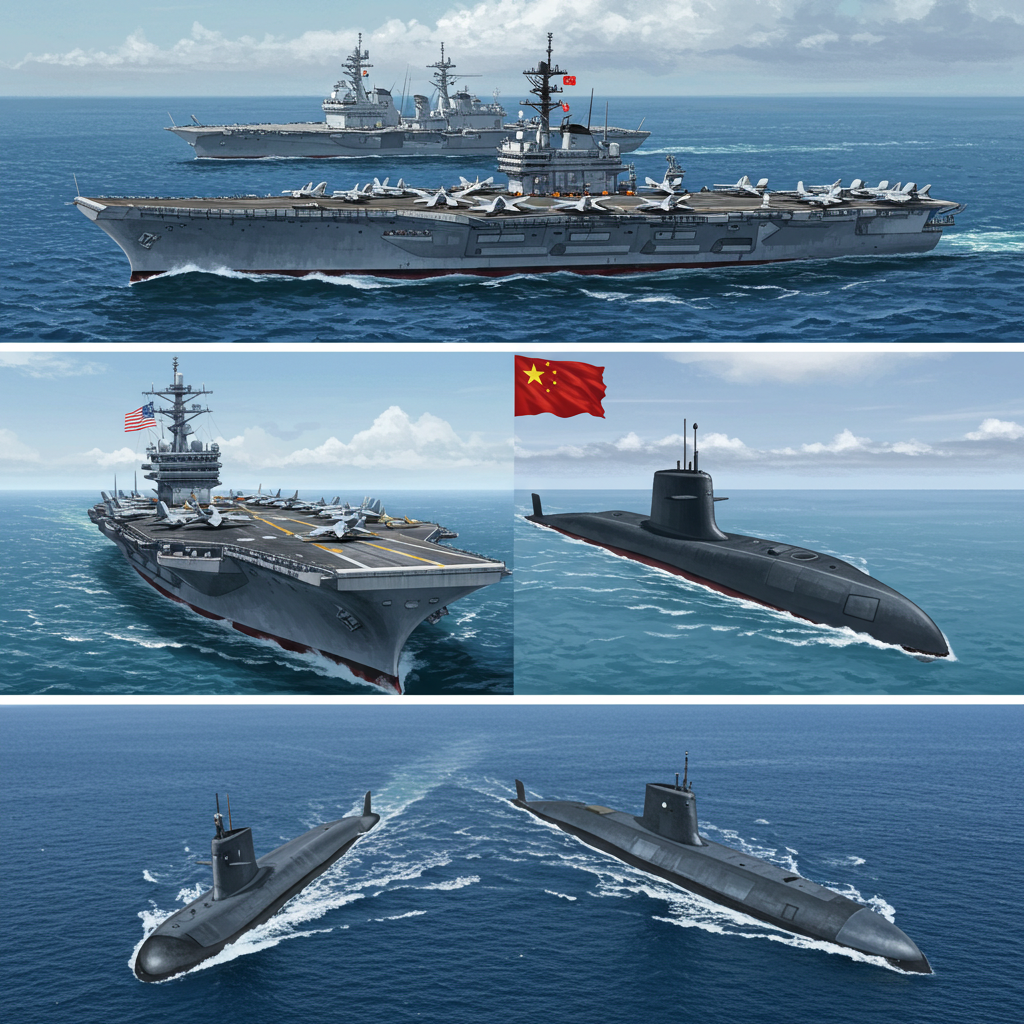Explore the comprehensive comparison of military power between the USA and China in 2025. Discover key insights, statistics, and future projections.
Introduction

As we move further into the 21st century, the military capabilities of nations have become a focal point of global politics and security. The rivalry between the United States and China is particularly significant, as both countries continue to expand and modernize their armed forces. By 2025, the landscape of military power will have evolved, with advancements in technology, strategy, and international alliances playing crucial roles. This blog explores the military power comparison between the USA and China in 2025, examining key aspects such as personnel, technology, naval capabilities, air power, and strategic partnerships.
Historical Context
The United States has long been recognized as the world’s foremost military power, a status solidified after World War II and during the Cold War. The end of the Cold War saw the U.S. military engaged in various conflicts across the globe, from the Gulf War to operations in Afghanistan and Iraq. Meanwhile, China, traditionally focused on regional issues, has rapidly modernized its military since the late 20th century, aiming to assert its influence in the Asia-Pacific region and beyond.
In recent years, tensions between the two nations have escalated due to trade disputes, territorial claims in the South China Sea, and differing political ideologies. As both nations prepare for a potential confrontation, understanding their military capabilities is crucial.
Military Personnel
United States Military Personnel

As of 2025, the United States military comprises approximately 1.3 million active-duty personnel, with an additional 800,000 in the reserves. The U.S. military is known for its highly trained and professional force, with a focus on technological superiority and rapid deployment capabilities. The U.S. Armed Forces are divided into five branches: the Army, Navy, Air Force, Marine Corps, and Coast Guard, each equipped to handle various aspects of warfare.
Chinese Military Personnel

China’s People’s Liberation Army (PLA) has around 2 million active-duty personnel, making it the largest military force in the world. The PLA is undergoing significant reforms aimed at modernizing its structure and improving its capabilities. The Chinese government has increased defense spending, focusing on enhancing the quality of its personnel through better training and education. The PLA consists of the Ground Force, Navy, Air Force, Rocket Force, and Strategic Support Force, reflecting a comprehensive approach to modern warfare.
Comparison
While the United States maintains a smaller active-duty force, its personnel are often considered more technologically advanced and better trained. In contrast, China’s sheer size provides it with a significant advantage in manpower, which can be crucial in large-scale conflicts. However, the effectiveness of military personnel is not solely determined by numbers; training, morale, and leadership also play vital roles.
Technological Advancements
United States Military Technology
The U.S. military is renowned for its technological edge, investing heavily in research and development. By 2025, advancements in artificial intelligence (AI), cyber warfare, and unmanned systems are expected to redefine modern combat. The U.S. is also focusing on next-generation fighter jets, such as the F-35 Lightning II, and advanced naval vessels equipped with cutting-edge weaponry.
Additionally, the U.S. military has made significant strides in missile defense systems, cyber capabilities, and space operations, ensuring it remains a formidable force in the face of evolving threats.
Chinese Military Technology
China has made remarkable progress in military technology, narrowing the gap with the United States. The Chinese government has prioritized the development of indigenous defense technologies, leading to advancements in missile systems, naval capabilities, and cyber warfare. By 2025, China is expected to field advanced fighter jets, such as the Chengdu J-20, and modern naval vessels, including aircraft carriers and submarines.
China’s focus on AI and drone technology is also noteworthy, with investments aimed at enhancing its surveillance and reconnaissance capabilities. Furthermore, China’s growing emphasis on space capabilities highlights its ambition to compete with the U.S. in this critical domain.
Comparison
While the U.S. maintains a technological edge, China’s rapid advancements pose a challenge. The competition between the two nations in areas such as AI, cyber warfare, and space is likely to shape future military strategies. The effectiveness of technology will ultimately depend on how well each country integrates these advancements into their military operations.
Naval Capabilities
United States Naval Power
The U.S. Navy is one of the most powerful maritime forces in the world, boasting a fleet of aircraft carriers, submarines, and surface ships. By 2025, the U.S. Navy is expected to maintain around 11 aircraft carrier strike groups, providing unparalleled power projection capabilities. The Navy’s ability to operate globally, coupled with advanced naval technologies, ensures it can respond swiftly to emerging threats.
The U.S. also emphasizes naval aviation, with advanced aircraft such as the F/A-18 Super Hornet and the F-35C Lightning II enhancing its carrier operations. Additionally, the Navy’s focus on missile defense and anti-submarine warfare capabilities further strengthens its position.
Chinese Naval Power
China’s naval expansion has been rapid and strategic, with the PLA Navy (PLAN) becoming a formidable force in the Asia-Pacific region. By 2025, China is expected to have a fleet of approximately 400 ships, including multiple aircraft carriers, advanced destroyers, and submarines. The PLAN’s focus on blue-water capabilities signifies its ambition to project power beyond its shores.
China’s development of anti-access/area denial (A2/AD) strategies aims to deter U.S. naval forces from operating freely in the region. The construction of artificial islands in the South China Sea serves to enhance its maritime presence and assert territorial claims.
Comparison
The U.S. Navy retains a qualitative edge in terms of technology and operational experience, while China’s quantitative growth poses a significant challenge in regional waters. The balance of naval power will heavily influence the dynamics of any potential conflict, particularly in the Indo-Pacific region.
Air Power
United States Air Power
The U.S. Air Force is known for its superior air power, with a diverse fleet of advanced aircraft designed for various roles, including air superiority, ground attack, and reconnaissance. By 2025, the Air Force is expected to operate next-generation fighters such as the F-35 and the B-21 Raider, enhancing its capabilities in both conventional and asymmetric warfare.
The U.S. also maintains a robust fleet of bombers, transport aircraft, and unmanned aerial vehicles (UAVs), allowing for rapid response and global reach. The integration of advanced technologies, such as stealth and precision-guided munitions, ensures the U.S. Air Force remains a dominant force in the skies.
Chinese Air Power
China’s air force, the People’s Liberation Army Air Force (PLAAF), has undergone significant modernization efforts in recent years. By 2025, the PLAAF is expected to operate advanced fighter jets, including the J-20 stealth fighter and the J-10 multirole fighter. China’s focus on developing its indigenous aircraft manufacturing capabilities has led to a more capable and diverse fleet.
China is also investing in UAV technology and air defense systems, enhancing its ability to conduct operations in contested environments. The integration of advanced radar and missile systems further strengthens the PLAAF’s capabilities.
Comparison
While the U.S. Air Force maintains a technological edge and operational experience, China’s rapid advancements in air power present a growing challenge. The competition for air superiority will be a critical factor in any potential conflict, with both nations seeking to leverage their capabilities effectively.
Strategic Partnerships
United States Alliances
The United States has a network of strategic alliances and partnerships that enhance its military capabilities. NATO, bilateral agreements with countries such as Japan, South Korea, and Australia, and partnerships in the Indo-Pacific region provide the U.S. with a significant advantage in terms of collective security.
These alliances enable the U.S. to project power globally and enhance interoperability among allied forces. Joint exercises and training programs further strengthen these relationships, ensuring that allies can respond effectively to emerging threats.
Chinese Partnerships
China has been actively seeking to expand its influence through strategic partnerships, particularly in Asia and Africa. The Belt and Road Initiative (BRI) serves as a platform for enhancing economic and military ties with partner countries. China’s growing relationships with nations such as Russia, Pakistan, and Iran provide it with a network of allies that can counterbalance U.S. influence.
China’s participation in regional security organizations, such as the Shanghai Cooperation Organization (SCO), further demonstrates its commitment to building a multipolar world order. These partnerships enable China to enhance its military capabilities and project power in its vicinity.
Comparison
The U.S. benefits from a well-established network of alliances that enhances its military capabilities and deterrence posture. In contrast, China’s partnerships are more focused on economic and political influence, although they are increasingly incorporating military dimensions. The effectiveness of these alliances will play a crucial role in shaping the strategic landscape in 2025.
Conclusion
The military power comparison between the USA and China in 2025 reveals a complex and evolving landscape. While the United States maintains a technological edge and a robust network of alliances, China’s rapid modernization and expansion of its military capabilities present a significant challenge. The balance of power will be influenced by advancements in technology, strategic partnerships, and the ability of each nation to adapt to changing geopolitical dynamics.
As both nations continue to assert their influence on the global stage, understanding their military capabilities will be essential for policymakers, analysts, and citizens alike. The rivalry between the USA and China will undoubtedly shape the future of international relations and global security in the years to come.

